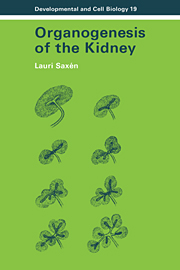Book contents
6 - Concluding remarks
Published online by Cambridge University Press: 22 October 2009
Summary
Control mechanisms
Figure 6.1, modified from previous schemes by Lehtonen & Saxén (1986a) and Saxén & Lehtonen (1986), summarizes much of our present knowledge of various molecular and structural events linked to the early, postinductory development of the secretory nephron. This process should be considered as a simple example of organogenesis singled out from a more complex process and consisting of a variety of developmental events not unique to the kidney: induction, proliferation, alternations in the intracellular and extracellular protein constituents, changes in cell shape and motility, and ultimately the assembly of cells into aggregates which gradually adopt organ- and tissue-specific formations with specific cellular phenotypes. These various processes have been documented in the previous chapters, but it is still not easy to find causal relationships within the general framework. Needless to say, such an analytical exercise will comprise – in addition to observations and facts – speculations and hypotheses.
The three main types of response of the nephric mesenchymal cells to an inductive stimulus are listed in the chart: documented events, their postulated and mostly unknown molecular basis, and their apparent morphogenetic consequences. The observed postinductory changes can be divided into three main types: (1) stimulation of the DNA synthesis (and proliferation) of the target cells, (2) disappearance (degradation) of the interstitial-type proteins from the extracellular matrix, and (3) enhanced (or neo-) synthesis of epithelial-type proteins of the extracellular matrix (ECM) and the cytoskeleton.
Proliferation of the induced cells is apparently stimulated and maintained by a dual control mechanism. The initial stimulation (12 to 24 h) depends on a persisting contact with the inductor and is probably emitted by a mitogen. Soluble growth factors are not required at this stage.
- Type
- Chapter
- Information
- Organogenesis of the Kidney , pp. 143 - 146Publisher: Cambridge University PressPrint publication year: 1987

